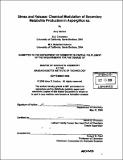Stress and release : chemical modulation of secondary metabolite production in Aspergillus sp.
Author(s)
Hanlon, Amy
DownloadFull printable version (9.070Mb)
Other Contributors
Massachusetts Institute of Technology. Dept. of Chemistry.
Advisor
Sarah E. O'Connor.
Terms of use
Metadata
Show full item recordAbstract
Cyclosporin A induced biosynthesis of colored compounds in three species of Aspergillus. Diode array HPLC MS analysis of culture extracts revealed Aspergillus terreus demonstrated the most profound response, with upregulation of more then twelve compounds from three distinct chemical families; butyrolactones, aspulvinones, and asterriquinones. Compounds from these three families are prenylated, and biosynthetically derived from homodimers of amino acids. The majority of the upregulated compounds were the aspulvinones, a class of butenolides. Structural elucidation of four isolated aspulvinones revealed both known and novel structures. Inducer concentration had a significant impact on aspulvinone profile. Bioassay revealed previously unreported antibacterial activity for the aspulvinones. A high-throughput colorimetric screen was designed to probe the response. The screen of 2480 known bioactives revealed multiple compounds capable of inducing aspulvinone production, and one compound, rapamycin, capable of inhibiting the response. Additionally, the increase in aspulvinone production was correlated with a decrease in culture density, indicating aspulvinone production is a general stress response.
Description
Thesis (S.M.)--Massachusetts Institute of Technology, Dept. of Chemistry, 2006. Includes bibliographical references (leaf 18).
Date issued
2006Department
Massachusetts Institute of Technology. Department of ChemistryPublisher
Massachusetts Institute of Technology
Keywords
Chemistry.